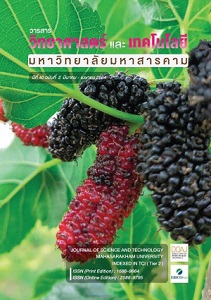INDOOR AIR QUALITY AND THEIR ASSOCIATIONS WITH SKIN RELATED SYNDROME AMONG MEDICAL STUDENTS DURING GROSS ANATOMY DISSECTION
Main Article Content
Abstract
The purpose of this cross-sectional study was to assess associations of skin related syndrome (SRS) related to indoor air concentration in a dose-dependent manner among medical students during gross anatomy dissection at a university in Thailand. The study was conducted between August to November 2018 and the data were collected for four months. Data collection involved using questionnaires which were developed by the researchers. The questionnaires contained items related to population characteristics, building characteristics, and SRS. Pearson’s correlation coefficient and spearman’s rank correlation were used to analyze data. The results showed that 12 factors significantly associated with SRS during gross anatomy dissection of medical students (P<0.05). Apparently, there are three influencing variables which included relative humidity, total bacteria in indoor air, and light intensity as tested using regression analysis. A regression model was run to predict the SRS of medical students from the 3 variables. These variables could significantly predict the SRS of medical students with a total of 99.1% (R2=0.991). Therefore, efforts should be made to manage those variables by applying the engineering approach to controlling indoor air quality in the gross anatomy laboratory room.
Article Details
References
AN, H., MAINELIS, G. & YAO, M. 2004. Evaluation of a high-volume portable bioaerosol sampler in laboratory and field environments. Indoor air, 14, 385-393.
ARIKAN, I., TEKIN, Ö. & ERBAS, O. 2018. Relationship between sick building syndrome and indoor air quality among hospital staff. La Medicina del lavoro, 109, 435-443.
BAK, J. J., CHO, S. H., PARK, B. J. & KANG, D. H. 1997. Sick Building Syndrome and the Related Factors in Office Workers. Journal of Preventive Medicine and Public Health, 30, 157-170.
CROOK, B. & BURTON, N. C. 2010. Indoor moulds, sick building syndrome and building related illness. Fungal Biology Reviews, 24, 106-113.
EUROPE, W. H. O. R. O. F. 2010. WHO guidelines for indoor air quality: selected pollutants.
KAMONWAN PROMTES, O. K., KITIPHONG HARNCHAROEN, CHATCHAI EKPANYASKUL 2014. Cancer risk assessment of inhalation formaldehyde exposure among medical students during anatomy laboratory. THAI JOURNAL OF TOXICOLOGY, 29, 8-22.
LU, C., DENG, Q., LI, Y., SUNDELL, J. & NORBÄCK, D. 2016. Outdoor air pollution, meteorological conditions and indoor factors in dwellings in relation to sick building syndrome (SBS) among adults in China. Science of the Total Environment, 560, 186-196.
MADUREIRA, J., PACIÊNCIA, I., RUFO, J. C., PEREIRA, C., TEIXEIRA, J. P. & DE OLIVEIRA FERNANDES, E. 2015. Assessment and determinants of airborne bacterial and fungal concentrations in different indoor environments: Homes, child day-care centres, primary schools and elderly care centres. Atmospheric Environment, 109, 139-146.
MERRILL, R. M. 2008. Environmental epidemiology: principles and methods, Jones & Bartlett Learning.
PONSONI, K. & RADDI, M. S. G. 2010. Indoor Air quality related to occupancy at an air-conditioned public building. Brazilian Archives of Biology and Technology, 53, 99-103.
REUBEN, U., ISMAIL, A. F., AHMAD, A. L., MAINA, H. M. & DAUD, A. 2019. Indoor Air Quality and Sick Building Syndrome Among Nigerian Laboratory University Workers. Journal of Physical Science, 30, 179-195.
SAHLBERG, B., GUNNBJÖRNSDOTTIR, M., SOON, A., JOGI, R., GISLASON, T., WIESLANDER, G., JANSON, C. & NORBACK, D. 2013. Airborne molds and bacteria, microbial volatile organic compounds (MVOC), plasticizers and formaldehyde in dwellings in three North European cities in relation to sick building syndrome (SBS). Science of the total environment, 444, 433-440.
SUN, Y., ZHANG, Y., BAO, L., FAN, Z., WANG, D. & SUNDELL, J. 2013. Effects of gender and dormitory environment on sick building syndrome symptoms among college students in Tianjin, China. Building and Environment, 68, 134-139.
TAKAOKA, M., SUZUKI, K. & NORBÄCK, D. 2016. Sick building syndrome among junior high school students in Japan in relation to the home and school environment. Global Journal of Health Science, 8, 165.
YEO, Y., LEE, S., LIM, C., QUEK, L. & OOI, S. 2009. A review of elderly injuries seen in a Singapore emergency department. Singapore medical journal, 50, 278.
ZAMANI, M. E., JALALUDIN, J. & SHAHAROM, N. 2013. Indoor air quality and prevalence of sick building syndrome among office workers in two different offices in Selangor. American Journal of Applied Sciences, 10, 1140.


